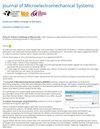Integrated Microfluidic System for Mechanical Agitation-Based Cell Lysis and Fluorescence Detection Using Reduced Amount of Reagent
IF 3.1
3区 工程技术
Q2 ENGINEERING, ELECTRICAL & ELECTRONIC
引用次数: 0
Abstract
Cell lysis is fundamental yet crucial for downstream bioassays. The use of chemical reagents will directly affect the subsequent workflows. Important research involving microfluidics is emerging in cell lysis, for its merits in less reagent usage and high automation of agent manipulation. In this study, a novel microfluidic system was designed and validated in achieving the synergistic effect of mechanical and chemical lysis. The consumption of cell lysis reagent is reduced by half without compromising lysis efficiency. A PDMS-based microfluidic system with a magnetically driven stirring bar enhances cell lysis through mechanical agitation. The lysed cell sample can be centrifuged into the detection chamber for observation. Experiments conducted using oral CAL-27 adenosquamous carcinoma cells showed that the mechanical shock generated in situ had a positive synergistic effect on chemical cell lysing, further optimizing traditional lysing procedures. The maximum cell lysis efficiency was improved from 88% to 94% while reducing the use of reagents. Critical parameters also enable similar lysis efficiencies at half the dosage required. This microfluidic system can enable on-site biological sample preparation for point-of-care detection, offering significant cost and time savings while ensuring high efficiency and reliability.[2025-0012]基于机械搅拌的细胞裂解和荧光检测集成微流控系统
细胞裂解是下游生物测定的基础和关键。化学试剂的使用将直接影响后续的工作流程。微流体因其试剂用量少、试剂操作自动化程度高等优点,在细胞裂解中出现了重要的研究成果。本研究设计并验证了一种新型微流控系统,实现了机械和化学裂解的协同效应。在不影响裂解效率的情况下,细胞裂解试剂的消耗减少了一半。一种基于pdms的微流体系统,具有磁驱动搅拌棒,通过机械搅拌增强细胞裂解。将裂解后的细胞样品离心后放入检测室观察。口服CAL-27腺鳞癌细胞的实验表明,原位产生的机械冲击对化学细胞裂解具有正向的协同作用,进一步优化了传统的裂解程序。在减少试剂用量的同时,最大细胞裂解效率从88%提高到94%。关键参数也可以在所需剂量的一半下实现类似的裂解效率。这种微流体系统可以实现现场生物样品制备,用于即时检测,在确保高效率和可靠性的同时,节省大量成本和时间。[2025-0012]
本文章由计算机程序翻译,如有差异,请以英文原文为准。
求助全文
约1分钟内获得全文
求助全文
来源期刊

Journal of Microelectromechanical Systems
工程技术-工程:电子与电气
CiteScore
6.20
自引率
7.40%
发文量
115
审稿时长
7.5 months
期刊介绍:
The topics of interest include, but are not limited to: devices ranging in size from microns to millimeters, IC-compatible fabrication techniques, other fabrication techniques, measurement of micro phenomena, theoretical results, new materials and designs, micro actuators, micro robots, micro batteries, bearings, wear, reliability, electrical interconnections, micro telemanipulation, and standards appropriate to MEMS. Application examples and application oriented devices in fluidics, optics, bio-medical engineering, etc., are also of central interest.
 求助内容:
求助内容: 应助结果提醒方式:
应助结果提醒方式:


